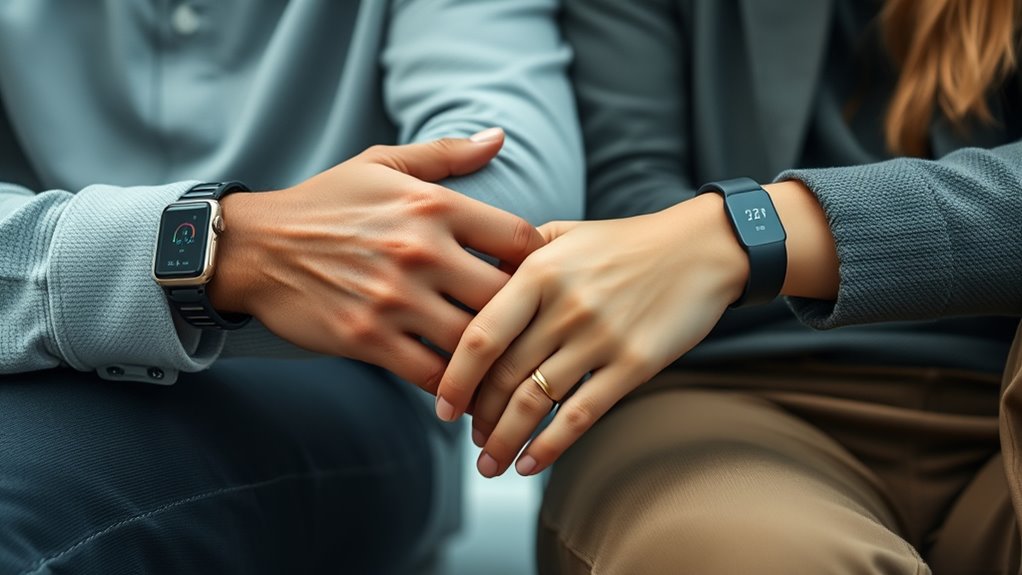Using wearables equipped with sensors, you can measure emotional contagion in real time by tracking physiological signals like heart rate variability, skin conductance, and temperature. These devices capture subtle physiological responses that reveal how emotions spread during social interactions. Advanced machine learning analyzes this data to identify emotional states and their transmission patterns. Exploring this technology further uncovers how it can enhance your understanding of social dynamics and emotional well-being.
Key Takeaways
- Wearables collect physiological signals like heart rate and skin conductance to objectively monitor emotional states linked to contagion.
- Real-time biometric feedback enables detection of emotional synchronization between individuals during social interactions.
- Multisensor data analysis, including features like heart rate variability and facial muscle activity, improves accuracy in measuring emotional spread.
- Machine learning algorithms classify emotional states from wearable data, facilitating assessment of emotional contagion dynamics.
- Ethical considerations, such as privacy and informed consent, are critical when using wearables to measure emotional contagion.
The Science Behind Emotional Contagion

Understanding emotional contagion begins with recognizing that emotions can spread between people almost effortlessly. When you’re around others, their emotional states can trigger emotional synchronization, where your mood aligns with theirs. This process, known as mood transfer, occurs through subtle cues like facial expressions, tone of voice, and body language. Neuroscience shows that mirror neurons in your brain activate during social interactions, helping you unconsciously imitate others’ feelings. mirror neurons play a crucial role in this automatic response, facilitating the rapid spread of emotions and making shared experiences powerful. Emotional contagion isn’t just about feeling happy or sad; it’s about the underlying neural mechanisms that allow emotions to ripple through groups. Recognizing this science helps you understand how emotions influence your behavior and relationships almost instantaneously.
Wearable Devices and Their Capabilities

Wearable devices have revolutionized how we monitor and understand our emotional states by providing real-time data through advanced sensors. These devices deliver biometric feedback, such as heart rate, skin conductance, and activity levels, giving you immediate insights into your emotional responses. By tracking these metrics continuously, wearables help increase user engagement, motivating you to recognize patterns and manage emotions more effectively. Their capabilities extend beyond simple step counting to complex emotional analysis, enabling personalized feedback and interventions. This immediate, actionable information fosters awareness and helps you tune into your feelings throughout the day. As a result, wearable devices empower you to explore emotional contagion and develop healthier emotional regulation strategies, making your mental health journey more informed and proactive. Additionally, these devices can be integrated with global intelligence systems to analyze emotional trends across populations, providing valuable insights for mental health initiatives and research.
Sensors and Data Collection Methods

You’ll want to contemplate the different types of wearable devices and how they gather physiological data to measure emotions accurately. These devices use various sensors to record metrics like heart rate, skin conductance, and temperature. Understanding the data acquisition techniques helps you evaluate how reliably these methods capture emotional states. For example, high refresh rates ensure real-time monitoring and more precise emotional detection.
Wearable Device Types
Different types of wearable devices employ a variety of sensors to gather data on physiological and behavioral indicators of emotion. Biometric accessories, like smartwatches and fitness trackers, are common choices. These devices often include accelerometers and gyroscopes to monitor movement and activity levels, which can reflect emotional states. Fitness trackers, in particular, focus on tracking heart rate, sleep patterns, and physical activity, providing valuable data for understanding emotions. Some biometric accessories also incorporate skin temperature sensors and galvanic skin response sensors to measure stress and arousal levels. These devices are designed to be worn continuously, offering real-time data collection. By using a mix of sensors, these wearables help capture an extensive picture of emotional responses, paving the way for more accurate measurement of emotional contagion. Additionally, advancements in data privacy challenges are crucial to ensure secure and ethical handling of the sensitive data collected by these devices.
Physiological Data Metrics
Physiological data metrics are derived from sensors that detect and record various bodily signals associated with emotional states. These sensors provide biometric feedback by capturing real-time data, such as heart rate, skin conductance, and temperature. These measurements serve as emotional biomarkers, offering insight into how your body responds to different feelings. Heart rate variability indicates stress or relaxation levels, while skin conductance reflects emotional arousal. Temperature changes can signal mood shifts, and respiratory rate offers additional context. By analyzing these metrics, you can objectively assess emotional contagion and understand how emotions spread through physiological responses. Additionally, Volkswagen Tuning techniques demonstrate how modifications can optimize engine performance, mirroring how fine-tuning physiological responses can enhance emotional regulation. This data forms the foundation for interpreting emotional states, enabling more accurate and nuanced measurements of emotional contagion using wearable technology.
Data Acquisition Techniques
To accurately measure emotional contagion, selecting appropriate sensors and data collection methods is essential. You need reliable tools for emotion detection while guaranteeing data privacy. Wearables like heart rate monitors, skin conductance sensors, and facial expression trackers can capture physiological signals linked to emotions. Consider the following:
- Using multi-modal sensors for exhaustive emotion detection
- Implementing secure data encryption to safeguard privacy
- Choosing unobtrusive devices for natural user interaction
- Regularly calibrating sensors to ensure accuracy
- Combining subjective surveys with physiological data for richer insights
- Selecting dog names that resonate with the breed’s temperament and personality to better understand emotional states.
Machine Learning Algorithms in Emotion Recognition

You’ll explore how machine learning algorithms process data from wearable sensors to recognize emotions accurately. Key points include the techniques used for data collection and feature extraction, which directly impact model performance. Understanding these aspects helps you evaluate algorithm effectiveness through various performance metrics. Incorporating well-being tips related to mental health can further enhance the accuracy and relevance of emotion recognition models.
Data Collection Techniques
Machine learning algorithms play a pivotal role in emotion recognition by analyzing data collected from wearable sensors. These techniques interpret physiological signals, such as heart rate, skin conductance, and facial expressions, to identify emotional states. When collecting data, you must consider cultural influences that shape how emotions are expressed and perceived. Privacy concerns are also paramount, as sensitive biometric information requires secure handling and user consent. To guarantee accurate emotion detection, you might:
- Use multimodal data from sensors
- Incorporate real-time monitoring
- Apply anonymization techniques
- Balance data diversity for cultural relevance
- Ensure compliance with privacy regulations
Feature Extraction Methods
Feature extraction methods are crucial in emotion recognition because they transform raw physiological data into meaningful representations that machine learning algorithms can interpret. By applying techniques like statistical measures, frequency analysis, and wavelet transforms, you can identify key features such as heart rate variability, skin conductance levels, and facial muscle activity. These features capture subtle emotional cues that raw data alone may miss, enabling more accurate emotion recognition. Selecting appropriate feature extraction methods improves model performance by reducing noise and dimensionality, making patterns more discernible. You should focus on extracting features that are robust and relevant to emotional states. Additionally, considering vehicle tuning modifications such as suspension upgrades can influence physiological responses during emotional states, further enriching the data collected for emotion analysis. Overall, effective feature extraction is essential for translating physiological signals into actionable insights in wearable-based emotion recognition systems.
Algorithm Performance Metrics
Evaluating the performance of machine learning algorithms is essential to determine their effectiveness in emotion recognition systems. You need to focus on key metrics like algorithm accuracy to see how well the model identifies emotional states. Real-time processing is critical for timely responses and meaningful emotional insights.
- Algorithm accuracy measures how correctly the system classifies emotions.
- Precision and recall evaluate the system’s ability to detect specific emotional states without false alarms.
- F1 score balances precision and recall for overall performance.
- Processing speed guarantees emotions are recognized in real time.
- Confusion matrix helps identify misclassification patterns to improve accuracy.
Applications of Wearable Technology in Social Settings

Wearable technology is transforming how we interact and understand emotions in social settings. By monitoring physiological signals, these devices facilitate emotional synchronization, helping groups bond more deeply. This technology enables you to analyze group dynamics and improve teamwork or friendships. Here’s how wearables are applied:
| Application | Benefit | Example |
|---|---|---|
| Emotional synchronization | Enhances group cohesion | Team-building activities |
| Social bonding | Deepens personal connections | Family gatherings |
| Stress management | Promotes emotional regulation | Workplace stress reduction |
| Mood tracking | Increases self-awareness | Counseling sessions |
| Group activity analysis | Improves collaboration | Educational settings |
Additionally, wearable devices can measure emotional contagion, providing insights into how emotions spread within groups and influencing social interactions.
Challenges and Ethical Considerations

As wearable devices become more integrated into social interactions, they also raise significant challenges and ethical questions. Privacy concerns are at the forefront, as sensitive emotional data can be misused or leaked. Ensuring informed consent is vital—users must understand what data is collected and how it’s used. You also face the risk of infringing on personal boundaries without realizing it. Additionally, there’s the potential for bias in data interpretation, which could lead to unfair outcomes. Maintaining transparency about data collection and respecting user autonomy are essential to address these issues. Moreover, implementing vetted data analysis protocols can help minimize errors and biases in emotional assessment.
Future Directions in Emotional Measurement

The future of emotional measurement with wearables promises to open deeper insights into human interactions and well-being. Advances will likely enhance your ability to monitor emotional regulation in real time, helping you understand how you manage stress or mood shifts. Wearables could also improve social synchronization by detecting subtle emotional cues during interactions, fostering better empathy and connection. As technology evolves, expect more sophisticated sensors and algorithms that capture nuanced emotional states more accurately. These tools might even suggest personalized strategies for emotional regulation, promoting mental health. In the future, wearable devices could become integral to social and emotional learning, empowering you to cultivate healthier relationships and greater self-awareness through continuous, precise emotional measurement.
Frequently Asked Questions
How Accurate Are Wearables at Detecting Complex Emotional States?
When it comes to detecting complex emotional states, wearables’ sensor accuracy varies. They excel at capturing basic emotions like stress or excitement through physiological signals but often struggle with emotional complexity. You might find that they give you useful insights, but they aren’t foolproof. Wearables can be helpful tools, yet they still have limitations in truly understanding nuanced emotional experiences. So, don’t rely solely on them for complete emotional insights.
Can Emotional Contagion Be Measured Across Different Age Groups Effectively?
They say “age is just a number,” but when it comes to measuring emotional contagion, age-related variability matters. You might find that wearables can capture some emotional shifts differently across age groups, affecting cross-generational applicability. While technology advances, the effectiveness of measuring emotional contagion across diverse ages still faces challenges, but with tailored algorithms and larger data sets, you can improve accuracy and better understand emotional influences across all age ranges.
What Privacy Measures Are in Place for Emotional Data Collection?
You should know that privacy measures like data encryption protect your emotional data from unauthorized access, ensuring your information stays secure. Consent management is essential, giving you control over what data is collected and how it’s used. These measures help you feel confident that your emotional information remains private and that you’re in charge of your personal data, especially when emotional responses are being monitored and analyzed.
How Do Cultural Differences Impact Emotional Contagion Measurements?
Think of emotional contagion as a global melody, where each culture plays a different tune. Cross-cultural variability shapes how emotions are expressed and perceived, influencing measurements. You must consider these differences, like adjusting a radio to the right frequency, to accurately capture emotional exchange. Cultural norms and expressive behaviors vary, so understanding these nuances helps you interpret data correctly, ensuring your wearable insights reflect true emotional states across diverse groups.
Are There Commercial Wearables Specifically Designed for Emotional Monitoring?
You might wonder if there are commercial wearables designed for emotional monitoring. These devices use emotion detection technology and wearable sensors to track physiological signals like heart rate and skin conductance that relate to emotional states. Some popular options include smartwatches and fitness bands with advanced sensors. While they aren’t explicitly designed for emotional monitoring, many can provide insights into your emotional well-being by analyzing these physiological cues.
Conclusion
As you explore the potential of wearables to measure emotional contagion, one thing becomes clear: we’re on the brink of unprecedented insights into human connection. But as technology advances, questions about privacy and ethics loom large. Will these devices truly reveal the secrets of our emotional worlds, or will they unveil surprises we’re not ready for? Stay tuned—what’s next could change how we understand ourselves and each other, forever.









